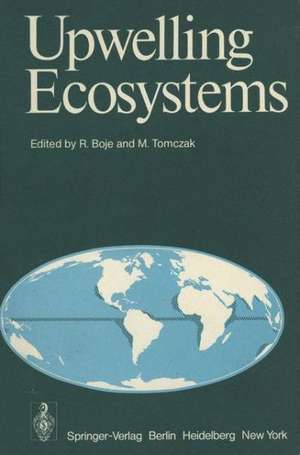Upwelling Ecosystems
Editat de R. Boje, M. Tomczaken Limba Engleză Paperback – 30 sep 1978
Preț: 643.84 lei
Preț vechi: 757.46 lei
-15% Nou
Puncte Express: 966
Preț estimativ în valută:
123.22€ • 127.29$ • 102.55£
123.22€ • 127.29$ • 102.55£
Carte tipărită la comandă
Livrare economică 25 martie-08 aprilie
Preluare comenzi: 021 569.72.76
Specificații
ISBN-13: 9783540088226
ISBN-10: 3540088229
Pagini: 320
Ilustrații: X, 306 p. 21 illus.
Dimensiuni: 170 x 244 x 17 mm
Greutate: 0.51 kg
Editura: Springer Berlin, Heidelberg
Colecția Springer
Locul publicării:Berlin, Heidelberg, Germany
ISBN-10: 3540088229
Pagini: 320
Ilustrații: X, 306 p. 21 illus.
Dimensiuni: 170 x 244 x 17 mm
Greutate: 0.51 kg
Editura: Springer Berlin, Heidelberg
Colecția Springer
Locul publicării:Berlin, Heidelberg, Germany
Public țintă
ResearchDescriere
Upwelling areas are among the most fertile regions of the ocean. In principle, upwelling is caused by the divergence of the flow in the surface layer of the ocean which arises as a consequence of a particular wind field, the presence of a coastline, or other special conditions. Since deeper oceanic layers are usually enriched wi th nutrients, it is the permanent supply of nutrients which forms the basis for the high producti vi ty of upwelling reg ions. The study of upwelling and its consequences were, for a long time, the task of individual scientists from all disciplines of marine science. Today, it is perhaps the branch of oceanography where interdisciplinary coopera tion has developed best. Becoming aware of the large potential yield of upwelling regions, governments in creased the funds for upwelling research. With research activities developed on a larger scale, interdisciplin ary cooperation became a necessity. On the international level, several symposia documented the rapid development. Three volumes reflect the results of these scientific meetings (Rapp. Proc.-Verb. 159, 1970; Inv. Pesq. 35, 1, 1971; Tethys §.' 1-2, 1974). The present book contains selected papers from the Third Symposium on Upwelling Ecosystems, which was held in Kiel in September 1975. Although the third of a series of meetings, it was the first where the word "ecosystem" stood in the title for a scientific program.
Cuprins
Ecosystem Research in Upwelling Regions.- Ecosystem Analysis and the Definition of Boundaries in Upwelling Regions.- What is an Upwelling Ecosystem?.- Mesoscale Heterogeneities of the Phytoplankton Distribution in the Upwelling Region of NW Africa.- On the Ecological Significance of Thalassiosira partheneia in the Northwest African Upwelling Area.- Zooplankton Communities in the West African Upwelling Area.- Relative Abundance of Zooplankton Groups in the Northwest African Upwelling Region During 1968 and 1972.- Mesodinium rubrum in the Baja California Upwelling System.- Regeneration of Nitrogen by Zooplankton and Fish in the Northwest Africa and Peru Upwelling Ecosystems.- Upper Trophic Levels in Upwelling Areas.- Food Consumption of Pelagic Fish in an Upwelling Area.- Benthos in Upwelling Regions.- Role of Bacteria in an Upwelling Ecosystem.- Heterotrophic Activity in the Mauritanian Upwelling in March 1973: Assimilation and Mineralization of Amino Acids.- Physical Aspects and Biological Consequences of Ghanaian Coastal Upwelling.- Oceanographic Conditions in the Galapagos Archipelago and Their Relationships with Life on the Islands.- Hydrographical Aspects of Upwelling Regions.- Role of Mixing in the Dynamics of Upwelling Systems.- The Circulation of Large Lakes.- Hydrologic Aspects of the Main Upwelling Areas off Peru.- Geological Aspects of Upwelling Regions.- Sediments as Indicators of Upwelling.- Sedimentation Influenced by Upwelling in the Subtropical Baie Du Levrier (West Africa).- General Aspects of Upwelling Research.- Upwelling Research and Ocean Affairs.









